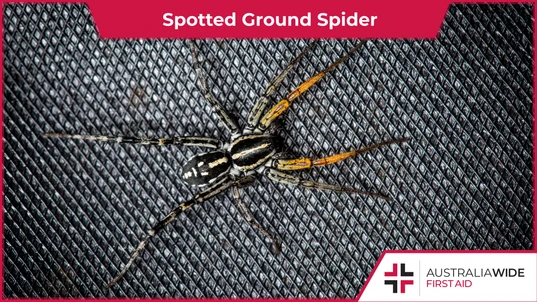Is the Spotted Ground Spider Poisonous?

Bites and Stings

The Spotted ground spider is widely distributed across Australia and commonly observed in households. Their legs can range from a speckled appearance to a vibrant orange colour.
The Spotted ground spider (Nyssus coloripes) is a vagrant species that is widely distributed across Australia. With their sometimes orange front legs and club shaped palps (appendages that sit near the mouth), these spiders have been known to enter houses at night and may give you a fright. In this article, we cover everything you need to know about the Spotted ground spider and answer the question - is their scary appearance indicative of an even scarier bite? We also cover spider bites in our general and childcare first aid courses. We have training locations in every state, capital city, and major town throughout Australia. Head to our website to find a first aid course near you today.Appearance
The Spotted ground spider can vary dramatically in appearance, which is why they are known by a host of different names, including the Orange legged swift spider and the Spotted ground swift spider. Their main identifying characteristics include:- Size ranging from 6 mm to 20 mm
- Dark body colour ranging from reddish to black
- Leg colour ranging from black and white to orange or red
- Two to five pairs of yellow spots on the top of their abdomen - these spots can also range from white to bright orange
Looking to get you First Aid knowledge up to date?
We run certified First Aid courses throughout all major Acustralian citys. Find a location near you.
Habitat
Male spotted ground spiders are always on the move hunting or searching for females. They can be found:- In leaf litter
- Under logs or rocks
- Indoors wandering across the floor
Habits
The Spotted ground spider is a hunting spider that ambushes ground dwelling insects. Females create oval egg sacs that can house roughly 50 eggs.Danger
Spotted ground spiders are not considered dangerous to humans, as they are timid in the face of conflict and reluctant to bite. Likewise, their bites generally only cause mild symptoms like a red welt and localised hot feeling. To treat:- Calm and reassure the casualty
- Apply a cold compress for periods of up to 20 minutes to reduce any swelling or pain
- Monitor for signs of deterioration or an allergic reaction and seek medical advice as necessary
Originally published at
https://www.australiawidefirstaid.com.au/resources/spotted-ground-spider
as part of the Australia Wide First Aid Articles Library









